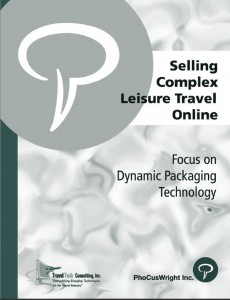- Have any questions?
- Office: +1 (650) 345-8510
- Mobile: +1 (650) 576-6916
- norm@traveltechnology.com
Leisure Travel Distribution 2004, Today and Tomorrow
Smart Mobs – Now a Reality
August 16, 2011Google Flights
September 13, 2011

In 2004, I authored and published in conjunction with PhoCusWright a study entitled “Selling Complex Leisure Travel Online- Focus on Dynamic Packaging”. This research described an emerging leisure travel distribution platform based on an N-Tier architecture which blends proprietary content with external connections to deliver dynamic packages that are personalized to a consumer’s needs. I am glad that many of the concepts I described in the study have come to fruition.
Since 2004 I have been involved with a number of technology procurement projects around leisure travel distribution and dynamic packaging. These projects have kept me up to date with offerings from vendors across the globe. The N-Tier architecture I described has now become standard with many vendors also embracing a Software as a Service (SaaS) model for delivery of their solution. Despite these advancements there are a few areas that seem to be lacking in current vendor offerings. These include:
- Personalization – Packaging based on true customer personalization using historical patterns, implicit and explicit preferences to alter content to meet customers’ specific needs.
- Connecting into social graphs. An additional way to make offers more personalized is to tap into the consumer’s social graph. Though the concept has been discussed by many, I have yet to see a solution that identifies a preference through social media; such as being a fan of a specific music group or sports team and then tying that preference into a booking suggestion (e.g. you are planning a trip to NYC and your favorite group will be giving a concert while you are there).
- Connecting to emerging content sources – With the growth of sites such as Home and Away and Airbnb, travelers now have a choice of accommodations beyond the traditional hotel room. Few vendors have actively pursued connections into these emerging platforms. Activities are also a ripe area of connectivity innovation. Activities represent an extremely fragmented market, but simply connecting into Viator is no longer a complete solutions with a range of sites now aggregating activity content.
- Mobile – With every sector becoming a retailer, selling package components or full blown dynamic packages on mobile devices should be a priority. Vendors need to open up their APIs to fully integrate with a customer’s existing Mobile Web or native apps enabling component and package sales on mobile devices. Tablets are un-tethering the planning process and thus specific applications for iPad and Android tablets can take advantage of location and provide the rich media needed for these devices.

